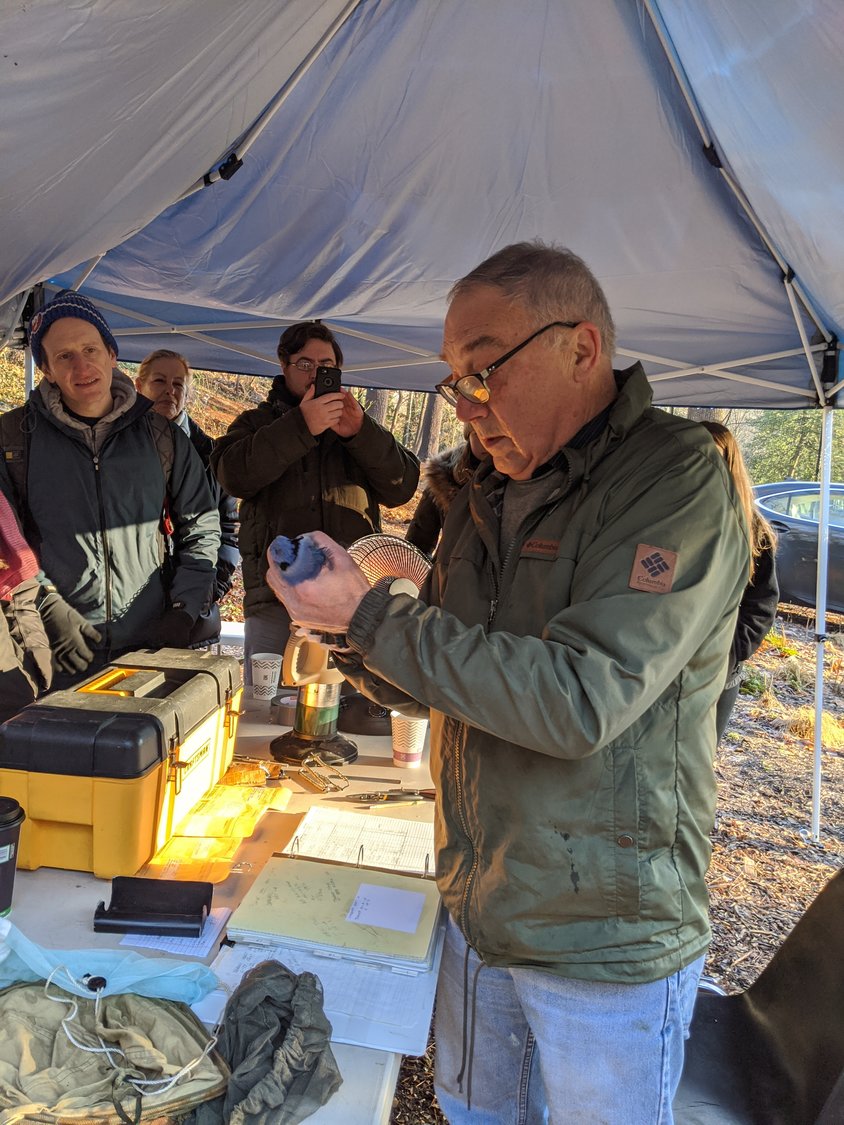Wednesday, April 24, 2024
 49.0°,
Fair
49.0°,
Fair
Birds of a feather flock to Oyster Bay’s sanctuary
Bird Banding 101 at Theodore Roosevelt Sanctuary
A group of about 30 nature enthusiasts and conservationists gathered at the Theodore Roosevelt Sanctuary and Audubon Center on Sunday to connect with birds in a special way. They were there to witness a process known as bird banding.
“Bird banding is really important when it comes to tracking birds and paying attention to trends in bird populations,” Diana Wilson, 22, an educator at the center, explained. “We capture the birds in mist nets and we get data on them — weight, size, stuff like that. Then we put bands on their legs that are identification tags.”
Once the data is collected, the birds are released, and return to their habitat unharmed.
The process requires the skill of a licensed bird bander. On Sunday, it was was seasoned veteran Harvey Farber.
“He typically bands on the South Shore during migration season,” said Kathryn D’Amico, the center’s manager. “So he’s only available a few times a year, mostly in the winter months. We try to get him out here then.”
Sitting under a canopy at a table with a heating unit and an array of bird banding equipment, Farber told the group of teenagers and adults that he had tracked bird populations since 1966. Last year alone, he banded over 700 birds from 40 to 50 different species. On Sunday he had to wait a little while before the first bird, a blue jay, was captured in the nets, which were slung between nearby poles.
Farber held the small bird carefully as it squirmed and tried to peck at his hand. He recorded the pertinent data and then attached the band to the bird’s leg, likening the process to putting a ring on a finger. Then he released the bird into the woods. The group watched, clearly fascinated.
“You see birds everywhere, all the time,” said Alex Braunstein, 14, from Huntington, “but you never get to see them up close, face to face.”
Asher Rosenberg, 75, from Syosset, is an avid birder. “This is my first time to the sanctuary,” he said, adding that he would definitely be coming back. “I was hoping they would ask for volunteers.”
Bird banding is vital to bird conservation and the study of bird habitats, D’Amico said, and it’s important to do it in the same location. “Then you can monitor the number of species, so if somebody wanted to study what birds are here in the winter, they can refer back to the data,” D’Amico explained. “Like they’ve caught goldfinches or downy woodpeckers in 2001 and still caught them in 2019, so it shows you that that population still exists.”
According to Wilson, banding can also give conservationists a heads-up about possible problems. “Getting the information helps us find out what birds might be in trouble, how they might be in trouble and in what areas,” she said. “It’s the first step. Then we can figure out, how can we help [them].”
The bird banding event, and similar programs, can also inspire a new generation of conservationists. Among those who took part on Sunday were about 10 volunteers from the center’s Teen Conservation Club.
“We’re really happy to have the teen group out here today,” D’Amico said. “We’re trying to get them involved in all the work we’re doing and on projects they’re interested in.”
The teenagers’ enthusiasm was evident. “We don’t study this in school, and I love learning about nature,” said Kayla Fives, 14, from Huntington. “It’s important to help save the birds and create a safe environment, because they balance the ecosystem.”
Casey DiGioia, 13, also from Huntington, said that what she was learning at the center was valuable. “A lot more young people are getting involved, because we want to make changes,” she said. “I want to keep doing this when I’m older.”
Programs like this also put young volunteers in contact with other conservationists. While the assembled group awaited the next bird, the participants chatted about their favorite birding spots. Cape May. Tobay. Cali, Columbia. They were clearly a passionate group. That’s part of the draw of events like this, D’Amico said. “I think it’s really important,” she said, “because it connects people with nature.”
HELP SUPPORT LOCAL JOURNALISM
The worldwide pandemic has threatened many of the businesses you rely on every day, but don’t let it take away your source for local news. Now more than ever, we need your help to ensure nothing but the best in hyperlocal community journalism comes straight to you. Consider supporting the Herald with a small donation. It can be a one-time, or a monthly contribution, to help ensure we’re here through this crisis. To donate or for more information, click here.
Sponsored content
Other items that may interest you







